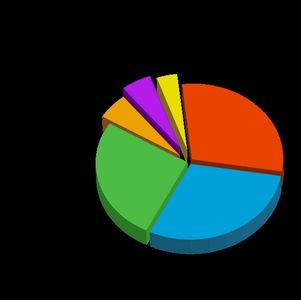The present tense (abbreviated pres or prs) is a grammatical tense that locates a situation or event in present time.[1] This linguistic definition refers to a concept that indicates a feature of the meaning of a verb. However, in discussions of specific languages, the term "present tense" is often used to refer to a particular grammatical form that, depending on the language, may frequently be used to express the present nature of an action or, in some cases, may be used to express non-present action. The discussion in this article focuses on the forms used in various languages. In English, present tense form may be used to express action in the present, a current state of being, an occurrence in the future, or an action that started in the past and continues. There are two common types of present tense form in most Indo-European languages: the present indicative (i.e., the combination of present tense and indicative mood) and the present subjunctive (i.e., the combination of present tense and subjunctive mood).

The present indicative of most verbs in modern English has the same form as the infinitive, except for the third-person singular form, which takes the ending -[e]s. The verb be has the forms am, is, are. For details see English verbs. For the present subjunctive, see English subjunctive. A number of multi-word constructions exist to express combinations of present tense with aspect. The basic form of the present tense is called the simple present; there are also constructions known as the present progressive (or present continuous) (e.g. am writing), the present perfect (e.g. have written), and the present perfect progressive (e.g. have been writing). Use of the present tense does not always imply present time. In particular, the present tense is often used to refer to future events (I am seeing James tomorrow; My train leaves at 3 o'clock this afternoon). This is particularly the case in condition clauses and many other adverbial subordinate clauses: If you see him,...; As soon as they arrive... In linguistics and rhetoric, the historical present (also called dramatic present or narrative present) refers to the employment of the present tense when narrating past events. Besides its use in writing about history, especially in historical chronicles (listing a series of events), it is used in fiction, for 'hot news' (as in headlines), and in everyday conversation (Huddleston & Pullum 2002: 129–131). In conversation, it is particularly common with 'verbs of communication' such as tell, write, and say (and in colloquial uses, go) (Leech 2002: 7). Literary critics and grammarians have said that the historical present has the effect of making past events more vivid. More recently, analysts of its use in conversation have argued that it functions not by making an event present, but by marking segments of a narrative, foregrounding events (that is, signalling that one event is particularly important, relevant to others) and marking a shift to evaluation (Brinton 1992: 221). In an excerpt from Dickens' David Copperfield, we can see that the shift from the past tense to the historical present gives a sense of immediacy, as of a recurring vision: “ If the funeral had been yesterday, I could not recollect it better. The very air of the best parlour, when I went in at the door, the bright condition of the fire, the shining of the wine in the decanters, the patterns of the glasses and plates, the faint sweet smell of cake, the odour of Miss Murdstone’s dress, and our black clothes. Mr. Chillip is in the room, and comes to speak to me. 'And how is Master David?' he says, kindly. I cannot tell him very well. I give him my hand, which he holds in his. (Chapter IX) ” Margaret Atwood's dystopian novel The Handmaid's Tale is entirely written in the historical present tense.
